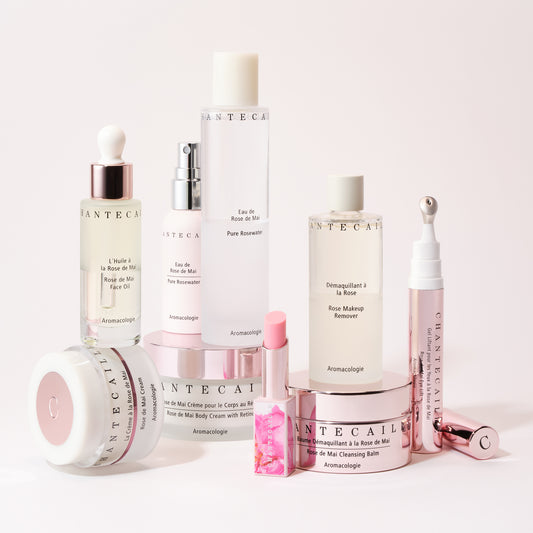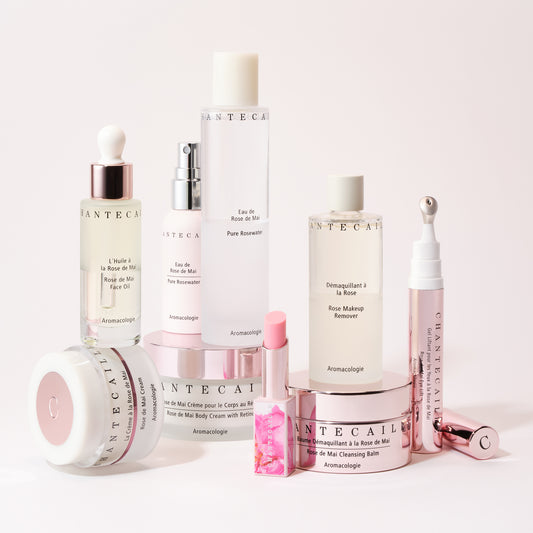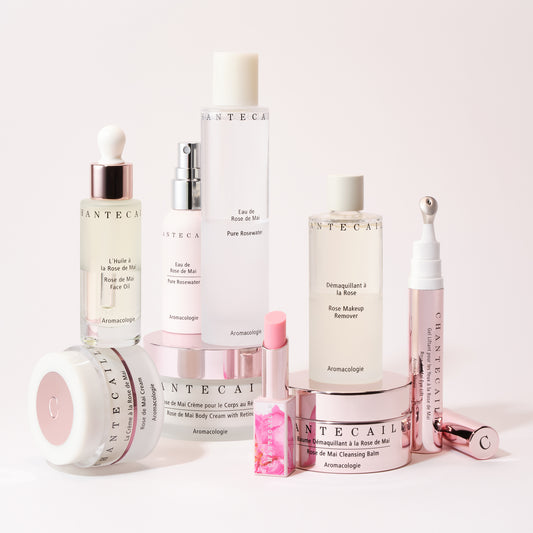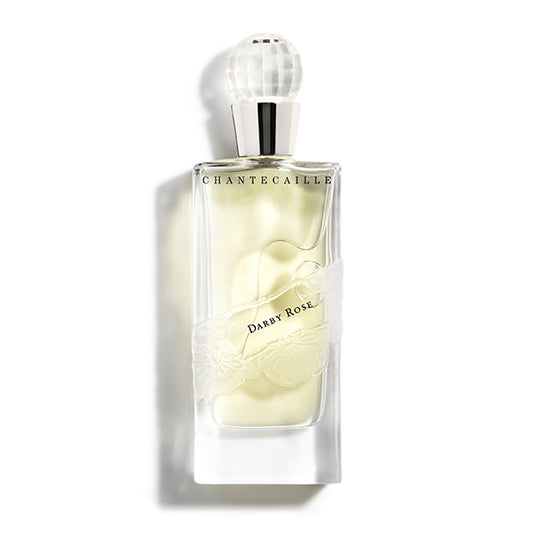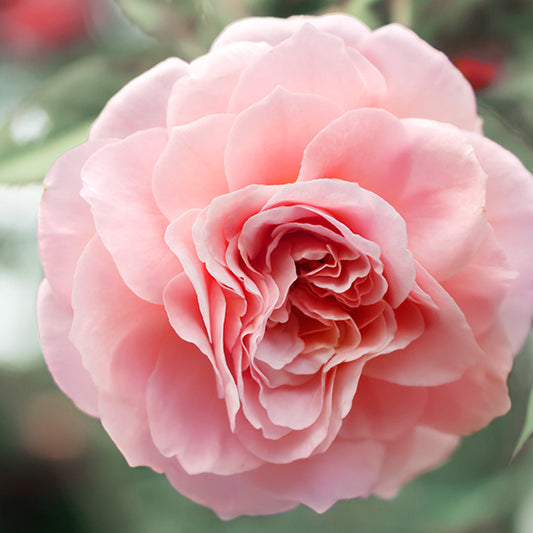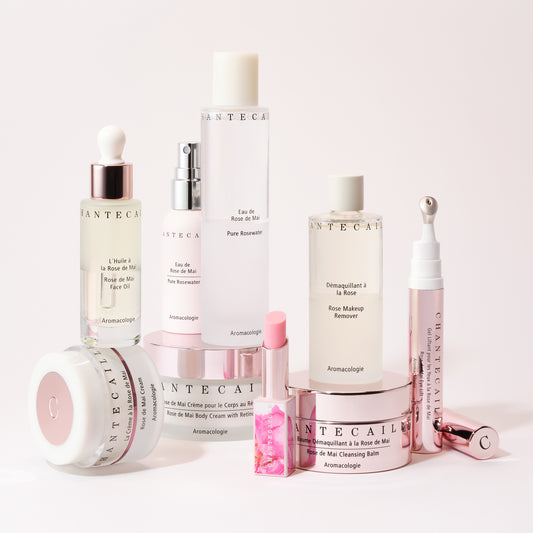
A rose arrangement by @bowsandarrowsflowers; photo by @jonachristinaphoto
La Vie en Rose
One of the most magical places we know, Rose Story Farm is an explosively blooming and exquisitely scented home to more than 30,000 rose bushes on the California coast. For rose month, we checked in with co-founder Danielle Hahn for the scoop on growing healthy roses—and a family business—successfully.
Did you know that the more fragrant a rose is, the faster it will wilt? We didn’t either. But it makes poetic sense, given how precious these natural treasures are. Few people know more about roses than Danielle Hahn of Rose Story Farm, who with her husband and family founded the business in 1998 with 1,000 rose bushes on half an acre near Montecito planted with lemon and avocado trees. Sylvie Chantecaille was one of the first visitors to the farm, Danielle recalls, and “we immediately felt a connection that continues to this day.” Today they’re up to 30,000 bushes of more than 120 varieties of organically grown roses, which feed – until Covid-19 disruptions required a pivot – a thriving business providing fresh blooms for events, restaurants and floral designers. Now anyone can buy a bouquet and have it shipped overnight.
Last November Danielle and Sylvie led a group from Chantecaille on a field trip to the farm for an afternoon of deeply inhaling, flower-arranging, and sipping a rosewater-infused cocktail. We loved it so much, we wanted to share what we learned.

Danielle Hahn, photo by @victoriapearsonphotographer; a bunch of Christopher Marlowe roses.
If a rose were a person, how would you describe him or her, versus other kinds of flowers?
Gorgeous, romantic, fun, adventuresome! There is no other flower with quite the history of the rose. They come in all colors, a multitude of shapes and sizes, and there are at least 10 fragrance families that can describe a rose. Their season is longer than most, and the metaphors never end: Every rose has its thorn. With beauty comes pain. But he that dares not grasp the thorn should never crave the rose (that’s Brontë). A bit of fragrance always clings to the hand that gives you roses (a Chinese proverb). My list goes on and on…
Do you have a favorite rose varietal?
My favorites change throughout the season. Right now, I’m crazy about a few: Grande Dame, Love Song, Scentuous, and Golden Celebration! All of these have tremendous (and unique) fragrance, spectacular color, and bloom prolifically throughout the season. In addition, they are all disease resistant, and have multiple blooms on a stem. I could go on and on.
"There is no other flower with quite the history of the rose."
You’ve said that your vision for Rose Story Farm was to be “an old-fashioned rose farm.” What does that mean to you and how did you grow your business on it?
I have always been a collector of sorts. I love anything that has history—we started with “old” roses for that reason. We had history with a few of the varieties we started with (our grandparents or parents grew them) and then we branched out.
We do everything by hand out here—we cut, clean, bunch and ship ourselves. We don’t have big machinery for any of our farm chores. We have tried to keep the “old fashioned” feel by simply making sure we are farming in a sustainable way, using hand labor and organic materials.
For the person who wants to grow roses but feels intimidated, what’s the best way to begin?
Rule of thumb, the most recently introduced varietals are typically the most disease resistant. You can also look for European varieties. Many (if not all) European countries have banned toxic pesticides, consequently their roses tend to be more disease resistant. Join a rose society if there is one near you. Visit botanical gardens and/or nurseries in your area and look at their roses. Make a list of the ones that look the healthiest. Ask questions, and then just jump in. Plant a few and see how they do for you. And don’t be afraid to get rid of a rose that isn’t doing well for you.

A field of iceberg roses at the entrance to the farm; arrangement photo by @victoriapearsonphotographer
What is the biggest mistake that novice rose gardeners make? Any other tips for success?
The biggest mistake we see when we visit private rose gardens is that the owners have picked too heavily early in the season. Remontant (or repeat flowering) roses have several bloom cycles throughout a season. If you cut too deeply into the plant during the first bloom cycle, the plant will not recover—they need their leaves for photosynthesis and root development. We tell our clients to simply pick the bloom and float it in a bowl if they must have roses during the first bloom cycle—on the next cycle, you can pick more flowers and deeper into the plant. By the end of the season, you can pick as long a stem as you desire and as many blooms as well. Always cut to an outside leaflet where the stem can support the next bloom. Give your roses a good pruning in the winter and spray with dormant oil to reduce disease spores in and around the plant. This is the single most important care chore when it comes to growing good roses.
Do you have any advice for buying and caring for cut roses?
Roses, by their very nature, are both fragile and unique. They do not last long once they are cut from their food source. The more fragrant the rose, the less time we have with them in a vase. Soft petals indicate an abundance of fragrance pores—the softer the petals, the more fragrance pores, and consequently the more fragile the flower.
Make sure your containers and clippers are ultra clean. Sharpen your shears every third time you use them, clean them after every use. Give your roses a fresh cut on an angle (so stems don’t rest flat in your container), place them in tepid water that is hopefully from an outdoor tap (or any water that is not filtered or softened as many households have). Keep the water topped off in your vase. For extra care, you may recut the stems and replace water daily.
And buy your roses from a reputable source—know your farmer! We cut our roses early in the morning or late in the afternoon. We then place them in a cooler so that they release their field heat. They are kept cool for a minimum of 6 hours before we ship them out or use them in our arrangements. You can expect your garden roses to last 3 to 5 days, no longer.

Overhead shot of Rose Story Farm.
When it comes to arranging, what is the best way to make them look like the gorgeous loose arrangements we saw in your home, and not so stuffy?
Choose the right container. We like vessels with a neck or narrowed opening so that the stems are gently supported. Choose a vessel with a large water capacity. We like pitchers, teapots, and the like for their shape. Gently cut off any thorns or leaves that will be below the water line. Gather your rose blooms in one hand and clip the bottoms evenly while measuring them against your container. Then place them loosely (in one motion) into your container. Adjust them, as desired, to fill the container evenly.
When we visited RSF last year we had the most wonderful time walking around on your beautiful property and sipped a delicious rose-inspired cocktail – can you share it with us?
Yes! It’s called the Juliet & Romeo:
2 oz gin
¾ oz lime juice
¾ oz simple syrup
3 dr rosewater
3 dr Angostura bitters
3 sprigs mint
Roses, as we know, possess amazing healing properties. Do you use roses in any other way besides decoratively?
We make rose petal tea (can be served hot or cold). This is great when you are fighting a cold! We also make rose hydrosol. This is a refreshing facial hydration spray. Keep it in the refrigerator for those hot summer days.

A bench at the farm, photo by @victoriapearsonphotographer; Claudio, who has worked at the farm for more than 20 years, photo by @jonachristinaphoto
How have the Covid-19 restrictions affected your business? Can customers place online orders now?
Covid-19 has completely upended our wedding and event business. Fortunately, we’ve been able to pivot from wholesale rose sales to retail rose sales. No longer are we shipping extra-large boxes with hundreds of roses—our average order now is for 20 to 30 stems sent to new and, for the most part, non-repeating customers. We have adjusted our website and added a retail page so that anyone can go online and order a bouquet sent to themselves or as a gift. We have local pick-up (contactless), delivery, and can ship overnight via Fedex to any of the continental United States.
Of course, we have to ask: Do you have a favorite Chantecaille product?
Honestly, there is nothing I don’t love, but of course I especially love all the Rose de Mai products for face and body. You used to have a body crème product made with the Darby Rose—yum. Happy to see that the Darby Rose perfume is back!
Shop This Story

